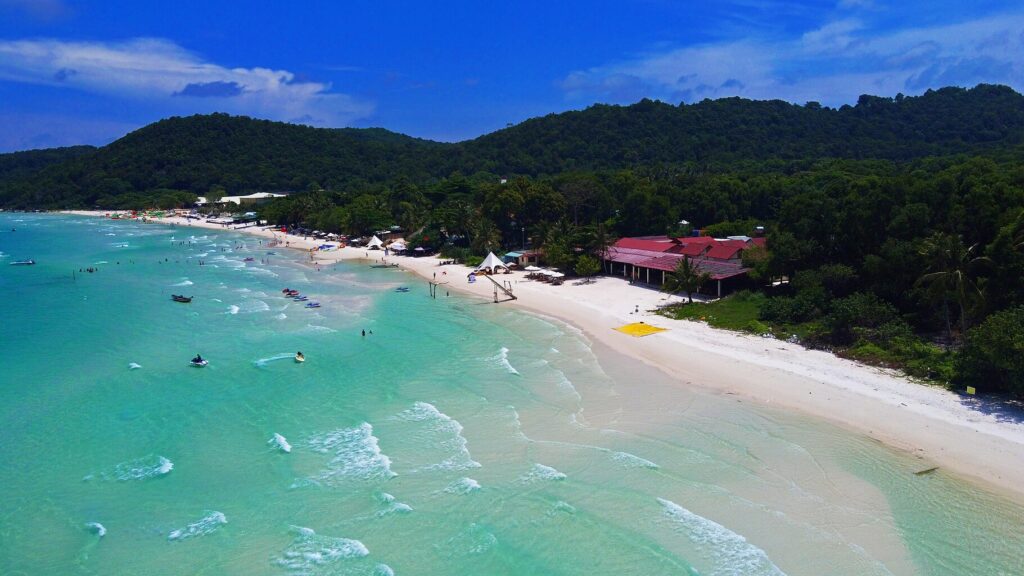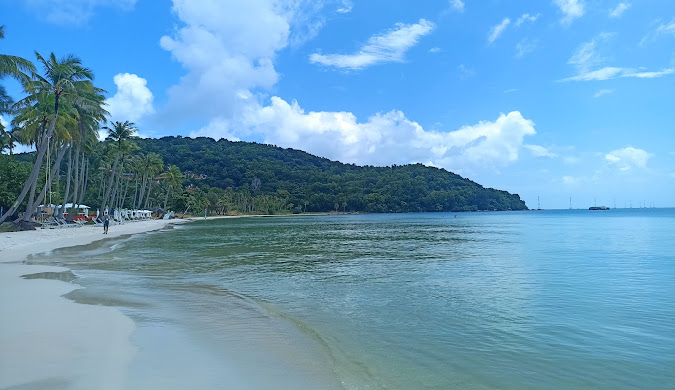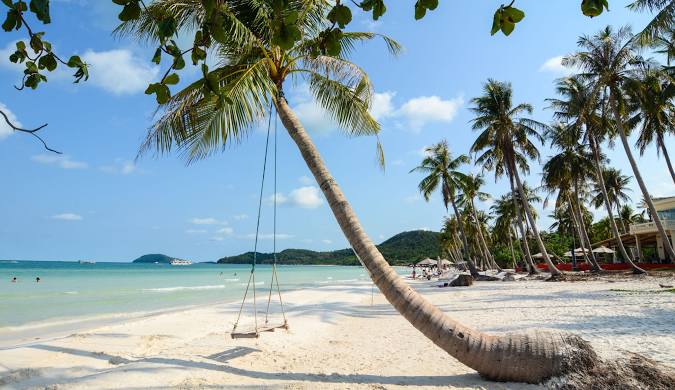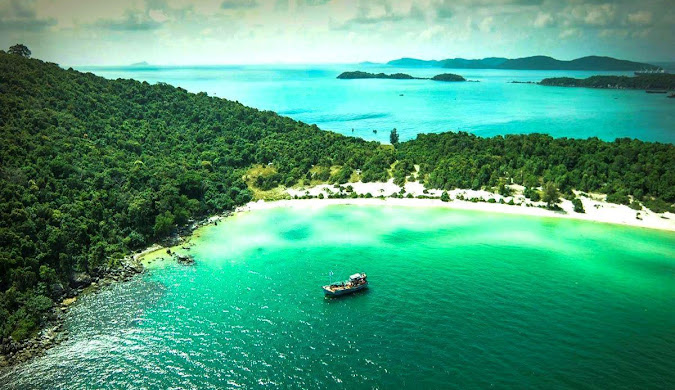Picture this: you’re lounging on powdery white sand, crystal-clear water lapping at your feet, and palm trees swaying gently in the warm breeze. Welcome to Phú Quốc, Vietnam’s largest island and one of Southeast Asia’s most stunning beach destinations. This tropical paradise offers everything from pristine beaches and vibrant coral reefs to lush rainforests and charming fishing villages. Whether you’re craving adventure, relaxation, or a bit of both, Phú Quốc delivers.
But here’s the question every traveler asks: when is the best time to visit Phú Quốc?
In this guide, I’ll walk you through everything you need to know about Phú Quốc weather, the differences between the dry season and rainy season, and how to choose the perfect time based on your travel style. Let’s get started!

Quick Snapshot — Best Time at a Glance
Not sure which season suits you? Here’s a quick breakdown:
| Season | Months | Weather | Best For | Crowds | Price Range | Sea Conditions |
| Dry Season | Nov–Apr | ☀️ Sunny, 25-30°C, Low humidity | Beach lovers, water sports, island-hopping | High | $$ | Calm & clear |
| Peak Dry Season | Dec–Feb | ☀️ Perfect sunshine, 26-28°C | Guaranteed beach weather | Very High | $$ | Excellent |
| Shoulder Season | Apr, May, Oct | 🌤️ Mostly sunny, occasional rain, 27-32°C | Balance of weather & value, photographers | Moderate | $ | Good to calm |
| Rainy Season | Jun–Sep | 🌧️ Afternoon showers, 25-31°C, High humidity | Budget travel, lush scenery, local culture | Low | $ | Rough, limited visibility |
Quick Tips by Season:
Dry Season (November–April)
- Best for: Classic beach weather, water sports, and island-hopping
- Weather: Sunny skies, calm seas, low humidity
- Crowds: High (peak tourist season)
- Prices: Higher rates for flights and hotels
- Book: 2-3 months in advance
Shoulder Months (April, May & October)
- Best for: Balance of good weather, fewer crowds, and better deals
- Weather: Mostly sunny with occasional rain showers
- Crowds: Moderate
- Prices: Mid-range, great value
- Book: 4-6 weeks ahead
Rainy Season (June–September)
- Best for: Budget travel, lush landscapes, and local experiences
- Weather: Short afternoon showers, higher humidity
- Crowds: Low (off-season)
- Prices: Lowest rates of the year (40-50% savings!)
- Book: Flexible cancellation recommended
Pro Tip: For the best of both worlds, budget-savvy travelers should target late April or October. You’ll enjoy pleasant weather without the peak-season price tags!

Understanding Phú Quốc’s Climate & Seasons
Phú Quốc has a tropical monsoon climate, which means it’s warm year-round with two distinct seasons. The island sits in the Gulf of Thailand, giving it slightly different weather patterns than mainland Vietnam.
Here’s what you need to know about the Phú Quốc climate:
- Average temperatures: 25-32°C (77-90°F) throughout the year
- Humidity: Ranges from comfortable (dry season) to high (rainy season)
- Rainfall patterns: The rainy season (May–October) brings regular afternoon showers, while the dry season (November–April) offers consistently sunny days
These seasons directly impact your experience on the island:
- Sea conditions: Calm and perfect for snorkeling during the dry season; potentially choppy with limited visibility during heavy rains
- Outdoor activities: Hiking, island tours, and beach days are easiest during the dry months
- Crowd levels: Peak season (December–March) sees the most visitors, especially around holidays
Understanding these patterns helps you plan the perfect Phú Quốc beach travel experience.

Dry Season (November–April) – Peak Time for Sun & Sea
If you’re dreaming of perfect beach weather, the dry season is your golden ticket. From November through April, Phú Quốc transforms into a sun-soaked paradise with some of the most stunning conditions you’ll find anywhere in Southeast Asia.
Weather Conditions
During these months, you can expect:
- Brilliant sunshine nearly every day
- Calm, turquoise seas with excellent visibility for underwater activities
- Low humidity that makes even hot days comfortable
- Gentle breezes perfect for evening strolls along the beach
The water is incredibly clear, making it ideal for Phú Quốc snorkeling and diving adventures. You’ll spot colorful fish, coral gardens, and maybe even sea turtles!
Activity-Focused Tips
This is the peak season for good reason. Here’s what you can enjoy:
- Snorkeling and diving at spots like An Thoi Islands with perfect visibility
- Island-hopping tours to explore hidden coves and deserted beaches
- Sunbathing at famous beaches like Long Beach or the stunning Bãi Sao (Starfish Beach)
- Sunset photography with reliably clear skies creating spectacular golden-hour shots
- Water sports including kayaking, jet skiing, and paddleboarding
Unique Tip: Even during peak season, you can beat the crowds by visiting beaches or popular attractions before 9 AM. You’ll have the sand practically to yourself and capture those Instagram-worthy shots without photobombers!
Booking & Budget
Here’s the reality: Phú Quốc’s dry season means higher prices. Flights and hotels charge premium rates, especially during major holidays like New Year’s and Tết (Vietnamese Lunar New Year, usually late January or early February).
Smart booking strategies:
- Book your accommodation and flights at least 2-3 months in advance
- Consider mid-week stays (Tuesday–Thursday) for slightly better rates
- Look for package deals that bundle flights and hotels
- Book directly with hotels—many offer perks like free breakfast or airport transfers
Yes, you’ll pay more during this season, but the guaranteed sunshine and perfect conditions often make it worth every penny.

Transition Months (April, May & October) – The Sweet Spot
Want to know a secret? The shoulder months are often the smartest choice for savvy travelers. April, May, and October offer a magical balance of decent weather, lighter crowds, and friendlier prices.
Define the Appeal
These transitional months sit between the dry and rainy seasons, giving you a taste of both worlds. The weather is still mostly pleasant, but you’ll avoid the peak-season chaos and costs.
Pros vs. Cons
Pros:
- Fewer tourists mean less crowded beaches and attractions
- Lower accommodation rates—often 20-30% cheaper than peak season
- Lush, vibrant landscapes, especially after the rains in October
- More authentic experiences with easier access to local culture
- Better photo opportunities with dramatic clouds and softer light
Cons:
- Weather can be unpredictable—you might get a few rainy days
- Some boat tours may be canceled if seas are rough
- Humidity starts climbing, especially in May
Unique Tip
The shoulder season is a photographer’s dream! The landscapes are incredibly lush and green (especially October), and the softer, more diffused light creates stunning images. If you’re seeking tranquility and don’t mind occasionally adjusting your plans, these months are perfect.
Planning Advice
For shoulder season travel:
- Book accommodations with flexible cancellation policies in case weather forces a date change
- Check weather forecasts 7-10 days before your trip
- Pack layers—mornings can be cooler, afternoons warm and humid
- Plan indoor backup activities just in case
April is particularly lovely as the dry season transitions out—you’ll still get plenty of sunshine with occasional refreshing breezes.
Rainy Season (May–October) – Hidden Benefits & Lush Landscapes
Don’t write off the rainy season just yet! While May through October brings more precipitation to Phú Quốc, it also offers unique advantages that many travelers overlook.
What to Expect
First, let’s bust a myth: the Phú Quốc rainy season doesn’t mean constant downpours. Here’s what actually happens:
- Short, intense afternoon showers (usually 1-3 hours) rather than all-day rain
- Mornings are often clear and beautiful
- Higher humidity that can feel sticky but keeps everything green
- Rougher seas with potentially limited visibility for snorkeling
- More dramatic skies with spectacular cloud formations
Travel Implications & Opportunities
Yes, some boat tours might get canceled due to rough seas. But here’s what you gain:
Alternative Activities:
- Spa days at resort spas or local wellness centers—perfect for rainy afternoons
- Culinary adventures exploring Phú Quốc’s famous fish sauce production or taking cooking classes
- Pearl farm visits at covered facilities where you’ll learn about Vietnam’s cultured pearl industry
- Hiking through Phú Quốc National Park, which becomes a lush, tropical wonderland
- Market exploration and cultural experiences in Dương Đông town
- Pepper farm tours to see Phú Quốc’s renowned black pepper plantations
Unique Tip
Here’s the hidden magic: the rainy season transforms Phú Quốc into an incredibly green and vibrant paradise. The island bursts with life, waterfalls flow stronger, and you’ll have beaches virtually to yourself. It’s also harvest season for Phú Quốc’s famous black pepper, giving you a chance to see authentic agricultural life.
With far fewer tourists, you’ll experience a more genuine side of island life—chatting with locals at markets, enjoying restaurants without reservations, and discovering hidden spots the crowds never see.
Preparation Advice
Pack smart for the rainy season:
- Light rain jacket or packable poncho
- Quick-dry clothing—synthetic fabrics dry faster than cotton
- Waterproof bag for electronics and important documents
- Non-slip shoes or sandals with good traction
- Insect repellent—mosquitoes are more active during wet months
- High SPF sunscreen—you can still burn on cloudy days!
Most importantly, embrace flexibility. If rain cancels your beach plans, you’ll discover that Phú Quốc has plenty to offer beyond the sand.
What’s the Best Time for You? A Traveler-Type Guide
Still not sure when to book your Phú Quốc adventure? Let’s match your travel style with the perfect season.
For Beach Lovers & Sun-Worshippers
Best months: November–April (dry season)
If your dream vacation involves endless sunshine, swimming in crystal-clear water, and working on your tan, the dry season is non-negotiable. You’ll get reliable weather, calm seas perfect for snorkeling, and ideal conditions for beach-hopping. Yes, you’ll share the sand with other tourists, but the guaranteed sunshine makes it worthwhile.
For Budget Travelers & Solitude Seekers
Best months: May–October (rainy season) or late April/early October (shoulder months)
Save serious money while enjoying a more peaceful Phú Quốc experience. Accommodation costs drop significantly, and you’ll have attractions mostly to yourself. Sure, you might get caught in an afternoon shower, but that just means more time for spa treatments, local cuisine exploration, or afternoon naps in your beachfront bungalow.
For Families with Children
Best months: December–March (core dry season)
When traveling with kids, predictability is key. The core dry season offers the most reliable weather for child-friendly activities like beach play, gentle snorkeling, and water park visits. Book early to secure family-friendly resorts with kids’ clubs and shallow beach access.
For Nature Lovers & Photographers
Best months: April, May, October (transition months)
The shoulder season offers the best of both worlds: lush scenery after the rains, dramatic lighting conditions, and fewer tourists blocking your shots. The landscapes are vibrant green, waterfalls are flowing, and you’ll capture unique images you won’t see during the dry season. Wildlife is also more active during these months.
Practical Planning Tips & Local Insights
Ready to start planning? Here are some insider tips to make your Phú Quốc travel experience smooth and memorable.
Booking Advice
- For dry season travel (Nov–Apr): Book flights and accommodation at least 2-3 months ahead, especially for December–March
- For shoulder/rainy season: You can often book 4-6 weeks out, but still check for deals earlier
- Consider direct flights if available—they’re worth the extra cost for convenience
- Look for resort packages that include airport transfers and some meals
Seasonal Packing List
Dry Season Essentials:
- Multiple swimsuits (so one can dry while you wear another)
- High-SPF sunscreen (50+ recommended)—the tropical sun is intense
- Wide-brimmed sun hat and sunglasses
- Light cover-ups for temples and restaurants
- Reef-safe sunscreen if you’re snorkeling
- Beach bag for day trips
Rainy Season Additions:
- Light rain jacket or poncho (don’t pack heavy raincoats)
- Waterproof bag or dry sack for electronics
- Quick-dry clothes—synthetic fabrics are your friend
- Closed-toe water shoes for slippery surfaces
- Insect repellent with DEET
- Lightweight long sleeves for sun and mosquito protection
Local Culture & Year-Round Attractions
No matter when you visit, don’t miss these Phú Quốc experiences:
- Fish sauce factories where you’ll learn about (and smell!) traditional production methods
- Pepper farms showcasing Phú Quốc’s world-famous black pepper
- Pearl farms with fascinating tours of cultured pearl creation
- Dương Đông Night Market for street food and souvenir shopping
- Phú Quốc Prison (Coconut Tree Prison) for historical context
- Sim Wine production tasting this unique local beverage
Unique Value Tip
Here’s a pro move: if you’re visiting during the shoulder or rainy season, plan a longer stay (5-7 days instead of 3-4). This flexibility allows you to work around potential rainy afternoons without feeling like bad weather ruined your trip. You’ll have plenty of sunny days mixed in, and the lower accommodation costs make extending your stay more affordable.
Also, mid-week arrivals (Tuesday–Thursday) often mean cheaper flights and better hotel availability, even during peak season.
Summary & Your Phú Quốc Adventure Awaits!
So, what’s the best time to visit Phú Quốc? Here’s your quick recap:
🌞 Dry Season (November–April): Perfect for beach lovers who want guaranteed sunshine, calm seas, and ideal conditions for water activities. Expect higher prices and more crowds, but the weather won’t disappoint.
🌤️ Shoulder Months (April, May, October): The sweet spot for travelers seeking a balance of good weather, fewer tourists, and better value. Great for photographers and those who don’t mind occasional rain.
🌧️ Rainy Season (May–October): Ideal for budget travelers and culture seekers who want to experience authentic island life. The landscape is lush, prices are low, and you’ll have beaches to yourself. Just pack that rain jacket!
The truth is, Phú Quốc is beautiful year-round. The island has something special to offer every type of traveler, regardless of when you visit. Your perfect time depends on what matters most to you—weather certainty, budget, crowds, or unique experiences.
Now that you know the best time to visit Phú Quốc for your travel style, it’s time to start planning! Check for the latest flight deals to Vietnam, book that dream beachfront bungalow, and get ready for an unforgettable island escape. Whether you’re snorkeling in crystal-clear waters, exploring pepper plantations, or simply swaying in a hammock with a fresh coconut, Phú Quốc is waiting to work its tropical magic on you.
Start packing—your island adventure begins now! 🏝️
FAQ (Frequently Asked Questions)
When is the absolute best month to visit Phú Quốc for beaches?
December through February offers the absolute best beach conditions. You’ll get consistent sunshine, calm seas, low humidity, and perfect water clarity for snorkeling. These months are the heart of the dry season with minimal chance of rain. Just remember to book early and budget for higher prices.
Is it a bad idea to visit Phú Quốc during the rainy season?
Not at all! The rainy season (May–October) isn’t as scary as it sounds. Rain typically comes in short, intense afternoon showers rather than all-day downpours. Mornings are often beautiful and clear. You’ll enjoy massive savings, virtually empty beaches, and a more authentic local experience. Just pack a rain jacket and keep your plans flexible. It’s actually a great time for travelers who want to avoid crowds and see the island at its greenest.
What is the weather like in Phú Quốc in April?
April sits at the tail end of the dry season, making it a fantastic time to visit. You’ll still get mostly sunny days with calm seas, but temperatures start climbing slightly (28-32°C/82-90°F). There might be occasional brief showers as the season transitions, but overall conditions remain excellent for beach activities. Best of all, crowds thin out and prices drop compared to peak months like January and February.
When is the low season in Phú Quốc for the best deals?
June through September is the lowest season with the best deals. This period sits in the middle of the rainy season, so you’ll find significantly discounted accommodation (sometimes 40-50% off peak prices) and cheaper flights. August and September typically have the most rain, but also the biggest bargains. If you’re flexible and don’t mind working around afternoon showers, your budget will thank you.
Can I still go snorkeling in Phú Quốc during the rainy season?
Yes, but with conditions. Snorkeling during the rainy season is possible on days when seas are calm, but visibility isn’t as good as the dry season. Heavy rains can stir up sediment and reduce water clarity. Your best bet is to check conditions day-by-day and book tours with flexible cancellation. Some snorkeling sites on the eastern side of the island tend to have better conditions during rainy season. Many resorts and tour operators will honestly tell you if conditions aren’t suitable—it’s worth asking before committing.
References & Sources
This guide draws from credible sources and local expertise to ensure accuracy:
- Vietnam National Administration of Tourism – Official tourism information and seasonal travel advice
- World Weather Online – Historical climate data and weather patterns for Phú Quốc
- Phú Quốc Tourism Portal – Local government tourism resources
- Lonely Planet Vietnam – Trusted travel guidance and seasonal recommendations
Article written for XploreHeaven.com – Your trusted source for authentic travel guides and insider tips.
Read more articles;
- Top Things to Do in Siem Reap: Ultimate 2025 Guide for Temples, Food & Hidden Gems
- What to Do in Dominica – From Black Sand Beaches to Boiling Lake (Ultimate Guide)
- Tbilisi Travel Guide 2025: 10 Must-See Sights, Best Eats & Hidden Local Gems
- Is Rann Utsav Worth Visiting? A Complete Guide to the Festival
- When Is the Best Time to Visit Phú Quốc? Season-by-Season Guide for Beach Lovers
